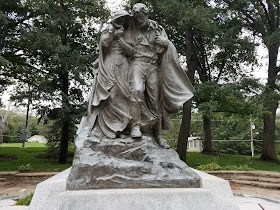The sites of the Mormon Battalion Mustering Grounds are
located near the intersection of U.S. 275 and state 92 in Council Bluffs. At
that intersection, U.S. 275 turns west and U.S. 375 continues north and crosses
Mosquito Creek.
Because I grew up in San Diego, I was often at the Mormon
Battalion Historic Site and Visitors' Center. My Strong ancestors participated
in the march west. So now I have been to both sides of the battalion.
We drove to the Kanesville Tabernacle. The missionaries
working there said that Russell M. Nelson was there the previous week. And even
he didn't know everything about this location.
The Kanesville Tabernacle was built in three weeks to have a
space large enough for a conference for the displaced pioneers to sustain
Brigham Young as Church president in December 1847 in the area of Council
Bluffs, Iowa.
“It was rough-hewn. It was hastily built. It wasn’t built to
last forever,” said President Richard L. Bennett, professor of Church history
and doctrine at Brigham Young University. “But what happened there would have a
permanent impact on the history of the Church, in that Brigham Young is
sustained as the next president of The Church of Jesus Christ of Latter-day
Saints” during a solemn assembly on Dec. 27, 1847.
The Kanesville Tabernacle, one of the first tabernacles
built by the Church, lasted a couple of years. It was rebuilt in the mid-1990s
and dedicated in 1996 by President Gordon B. Hinckley. They let me play the organ in the tabernacle. It wasn't as
old as the event, but built in the 1920s.
From here we went to the Mormon Trail Center on the Nebraska
side of the Missouri River. It was a large visitors' center with an astonishing number of displays. They mentioned that there was a quilt exhibit happening in
the basement, so I enjoyed an impromptu quilt show!

Across the street is the Winter Quarters Temple, the 104th
dedicated temple is the only one with a cemetery on the property. Dedicated by
President Hinckley in 2001, the groundbreaking ceremony was presided over by
Hugh W. Pinnock. He said the following at that event:
"It would be impossible to discuss the Winter Quarters
groundbreaking and the future temple to be located here without discussing
Council Bluffs [Iowa] just across the [Missouri] river, the Mormon Battalion
that was mustered there and that departed from that place. And yet, it's
difficult talking about Council Bluffs without acknowledging Mt. Pisgah and
Garden Grove, Iowa, which also provided temporary places of rest and
consolidation for the saints as they left Nauvoo, [Illinois] and as we focus momentarily
upon the many pathetic, painful problems the saints had encountered in Nauvoo
which led to their expulsion.
The Mormon Pioneer Cemetery is located at 3300 State Street
in present-day Florence at the north end of Omaha, Nebraska. The Cemetery is
the burial site of hundreds of Mormon pioneers who lived in Winter Quarters, a
temporary settlement that lasted from 1846 to 1848 as the settlers moved to
Salt Lake City.
Records of the Church indicate that 359 Mormon pioneers were
buried at the site. Remnants of three of the graves are visible today,
uncovered during the erection of a commemorative monument in 1936. The
monument, a bronze statue by Salt Lake City artist Avard Fairbanks, depicts
parents who have committed the body of an infant to the grave.

















No comments:
Post a Comment